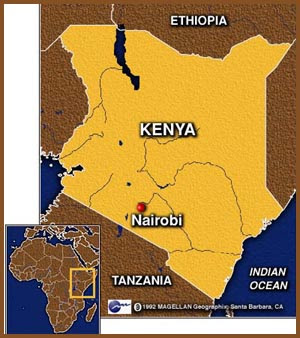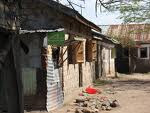[ . BACK to WORLDKIGO TOP . ]:::::::::::::::::::::::::::::::::::::::::::::::::::::::::::::::::::::::::::::::::::::::::::::::::::::
Posho mill
***** Location: Kenya
***** Season: Topic
***** Category: Humanity *****************************
Explanation
This is a mill that grinds your wheat or maize into flour.

Most Kenyans grow their own maize, the main staple food in Kenya, and if it is not eaten green (i.e. fresh) or cooked wholegrain in
githeri, they take it to the posho mill to be ground, so that the meal can be eaten as
ugali.
Isabelle Prondzynski
:::::::::::::::::::::::::::::::::::::::::::::::::::::::::::::::::::::::::::::::::::::::::::::::::::::
Posho Mills in Kenya
In Kenya, both in the rural and urban areas, posho mills play an important role in economic life of Kenyans; they pulverize maize grain, which is the staple food of the country, into flour (
unga). The flour is then used to prepare
ugali or
uji. Both are types of maize porridge -- ugali is tougher and firm, while uji has a soupy consistence.

Ugali is simple to prepare.
You just heat water to boiling point, then, using a cooking stick, add handful after handful of maize flour, stirring the mixture gently until it becomes firm. You then continue to heat it for some time more to make it firmer. It is best to keep turning the mixture in the
sufuria (saucepan) to make sure it is well cooked before transferring it to a plate. It is then served hot with the various vegetables or stew according to one’s own taste.
 David, a worker at the mill
David, a worker at the millPosho mills also grind other grain such as wheat and millet into flour. There are two types of posho mills: the electric posho mill and the diesel posho mill. The diesel posho mill is used in the remote and rural areas where there is no electricity. It has been in existence for a long time; in fact, it has been there since those days of the grinding mill. Before the diesel posho mill came into use, there was the grinding mill, which was operated manually by hand. It was very tedious as one had to turn the heavy wheel for some time.
Due to its laboriousness, it could produce only a little flour at a time, and the flour was coarse. Before the grinding mill came into existence, there was the grinding stone. This is the most traditional method of producing flour, still used by some of the most traditional communities in Kenya.
The grinding stone is simply a huge flat stone smoothened on the surface and the user uses a smaller stone to crush the grain between the two. The traditionalists argue that flour produced by the diesel and electric posho mills is contaminated with grease and oil hence not very not safe for human consumption. However, it is also argued that flour produced by the grinding mill contains minute stones, which come off the grinding stone surfaces due to friction. These minute stones are a health hazard as they may accumulate in the appendix and end up causing appendicitis.

The
electric posho mill on the other hand is found in urban centres with electricity supplies. They are made and operate in the same way as the diesel posho mills, only that they use electric power. The flour produced by these posho mills is supposed to be safer, but it is still argued that the oil and grease used to lubricate the machine’s mobile joints sometimes finds its way into the flour. It is also debatable that the metal parts which wear out may end up in the flour, as there is no place provided where the micro metal pieces can collect.
All in all, posho mills are crucial to the lives of most Kenyans. In the evenings mostly, you will see a long queue of tins or polythene bags full of maize grain waiting to be ground. It is mostly women and children who take the grain to the posho mills for grinding, but sometimes, also men, especially the single ones working in towns, are seen in the queues.
When maize grain is cheap after bountiful rains, the majority of Kenyans save money by buying maize grain and taking it to the posho mill for grinding into flour, instead of going for the fine and sifted flour (sold mostly in 1 kg or 2 kg packs) in the shops and supermarkets. The full maize grain is measured in a standard tin of 2 kg. This tin, which is a reused cooking oil container, is referred to as
korokoro. To grind a 2 kg tin of maize one is charged KShs. 10/-, while the maize in the same tin currently costs KShs. 50/-. The largest quantity of maize is the 90kg bag.
.................................................................................
WIMBIwimbi means
millet.
This posho mill grinds not only maize, but millet or wimbi as well. Wimbi is also called
bulo, obulo or
obule (Luhya).

Wimbi is one of the oldest grains to be grown by Kenyans, especially in Western and Nyanza. Wimbi has many domestic uses. One of them is the making of brown ugali or ugali ya wimbi as they call it. This type of ugali, is very special to the people of Western Kenya. It is eaten at all traditional ceremonies and rituals, the most remarkable one is being used during traditional weddings as a wedding cake.
The other use of wimbi is in the making of the traditional brew called
busaa (Swahili)
amalwa or
kamalwa (Luhya). The millet used in this process goes through a special process which includes being kept under wet condition away from sunshine for a week, during which it produces white shoots. It is then spread out in the sun to dry up until it is brown. It is at this stage that is taken into the posho mill to be ground into flour, but this flour is not ordinary flour; it is called
limela or
limira, meaning yeast, and it is used to ferment the traditional brew called kamalwa. Busaa or kamalwa is a product of maize fermented maize flour fried and mixed with water and limela and allowed to ferment for three days.
Millet flour is also used in the making of brown porridge, traditionally known as
buyu, obusera or
busera (Luhya). The Luo call it
nyuka. This is the most popular porridge in both rural and urban Kenya; you find it being sold even in big hotels, food kiosks, roadsides and even by hawkers.
To make the brown ugali even more delicious, the millet grain is usually mixed with pieces of cassava, which they call,
kumwoko or
omwoko (Huhoko: Swahili) and then taken into the posho mill for grinding. It makes a delicious meal when the brown ugali is eaten with meat and meat stew, chicken and chicken stew or fish and fish stew.
Text and Photos : Patrick Wafula
:::::::::::::::::::::::::::::::::::::::::::::::::::::::::::::::::::::::::::::::::::::::::::::::::::::
Millet and sorghum are native crops in Kenya and prized for their drought resistant qualities.
In recent years, they have both been largely replaced by maize in Kenyan agriculture and in the Kenyan diet. One reason for this is that millet takes a whole year to mature, while maize yields two crops in the course of a year. Millet is also very attractive to birds and has to be protected from them while ripening, which makes it a more expensive crop to produce.
They have a long history in Kenya and are still prized as oodstuffs on the important occasions in people's lives.
Millet porridge (uji) is much appreciated and health giving and is the regular breakfast in parts of the country. It is also easily transportable in thermos flasks and can therefore provide good sustenance to farmers as they go about their daily work.
A particular type of millet (
tef) grows only in Ethiopia and is essential for making injera, the Ethiopian staple carbohydrate.
Outside Ethiopia, the tef can be replaced with rice flour, which makes a decent enough
injera for those who cannot obtain the real thing.
Isabelle Prondzynski
The swahili name for sorghum is
mtama.
***************************** Worldwide use. Millet (hie, awa, kibi) Japan*****************************
Things found on the way*****************************
HAIKUhot evening--
chicks pecking maize grains
in the posho mill Alex Mwanambisi
:::::::::::::::::::::::::::::::::::::::::::::::::::::::::::::::::::::::::::::::::::::::::::::::::::::
power failure -
a posho-miller leans
on the engine James Bundi
:::::::::::::::::::::::::::::::::::::::::::::::::::::::::::::::::::::::::::::::::::::::::::::::::::::
posho mill --
a dove pecks crunched maize
under the sieve Isaac Ndirangu
April 2011*****************************Related words*****
Sufuria .. cooking pot or saucepan *****
Maize, Corn and githeri *****
Green Maize . . . ugali :::::::::::::::::::::::::::::::::::::::::::::::::::::::::::::::::::::::::::::::::::::::::::::::::::::















